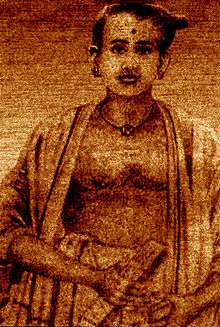Itty Achudan
Itty Achudan (forename also spelt as Itty Achuden in English, and Itti Achudem in Latin), who is known to have lived during the second half of the 17th century, was a distinguished ayurvedic physician, from the ancient Kollatt family of traditional Ezhava ayurvedic Vaidyans (doctors) of Kerala. The Kollatt family are natives of Kadakkarapally, a coastal village, north-west of Cherthala town, in Kerala, South India.
Itty Achudan Vaidyan | |
|---|---|
 | |
| Born | Circa 1640 AD |
| Occupation | Ayurvedic physician, Botanical expert, incumbent "Kollat Vaidyan" during the period 1670–1700 AD |
Contributions to Hortus Malabaricus
Itty Achudan co-authored with the three Konkani Brahmanas—Appu Bhat, Vinayaka Pandit and Ranga Bhat—the work of ethno-medical information titled Hortus Malabaricus. This 17th-century botanical treatise on the medicinal properties of flora in Malabar (present day Kerala) was compiled by the Dutch Governor of Malabar, Hendrik van Rheede, and published posthumously in Amsterdam between 1678 and 1693.
The ethno-medical information presented in Hortus Malabaricus was extracted from palm-leaf manuscripts maintained by Achudan, who was introduced to van Rheede by Veera Kerala Varma the then ruler of the erstwhile state of Kochi.
Volume 1 of the Hortus Malabaricus contains an original note by Achudan, dated 20 April 1675, in which he describes his contribution to the work.
Achudan is credited with having dictated the material, in his native Malayalam language, which was then translated into Latin. Part of the botanical information was scrutinised by the three Brahmanas and compared to a Konkani textbook “Mahanikhandu” (meaning "the great lexicon") followed by a process of thorough verification, discussion with other scholars and general agreement certified and signed in Konkani language with Devanagari Sript .
Kollatt family tradition
Historically the head medical practitioner of the Kollatt family was known as Kollatt Vaidyan. When a Kollatt Vaidyan died, his practice and title was inherited by his eldest son. The Kollatt Vaidyans maintained a family medical chronicle consisting of several volumes of palm-leaf manuscripts in Malayalam Kolezhuthu script. In these manuscripts were recorded names of medicinal plants, methods of preparation and application of drugs and the illnesses for which they were used. The Kollat family chronicle is said to have served as a compendium of ethno-medical knowledge, updated and enriched from time to time by recording the experiences of the individual incumbent Kollat Vaidyan.
Research on Itty Achudan’s life

Calicut University botany taxonomist Professor K. S. Manilal, of Kozhikode, devoted over 35 years to research, translation and annotation of the Latin Hortus Malabaricus. This revealed a wealth of botanical information on Malabar that had remained largely inaccessible to English-speaking scholars. Manilal's work is also of historic and socio-cultural importance, as it brought insights into the life and times of Achudan and the Ezhavas of 17th century Malabar, information concerning the former being previously known only to the Kollat family.
In 1996, Manilal also authored a separate book in the Malayalam language; the title which translates as A Study on the Role of Itty Achuden in the Compilation of Hortus Malabaricus.This book was the result of specific additional research undertaken with the objective of collecting factual evidence and clarifying various misconceptions, about the original Hortus Malabaricus, that had crept in through news media. It clarifies matters such as the number of pages per volume, the number of pictures, the publication date of the first volume, the publication date of the twelfth volume, and most importantly about the roles played by Achudan and others associated with assisting van Rheede with the compilation.
Memorial

Although none of the Kollatt family members today practise ayurvedic medicine, the family house at Kadakkarapally still has an ancient vilakku-maadam (lamp house) maintained, over the centuries in honour of Itty Achudan. The family home also has remains of a grove (kaavu) which includes ancient trees and medicinal plants.
Recognition
During the 19th century, Carl Ludwig Blume named a genus of plants Achudemia in honour of Achudan. This has now been included under Pilea (Urticaceae).
Over the last two decades, the Kollat family members have set up a socio-charitable trust in honour of Itty Achudan. The Government of Kerala announced that, in his honour, a portion of the Tropical Botanical Garden and Research Institute in Thiruvananthapuram would be set aside to introduce plants listed in Hortus Malabaricus.
References
- Horthoos Malabarikkoosum Itty Achudanum – Malayalam book by Dr. K.S. Manilal. A Study on the role of Itty Achudan in the compilation of Hortus Malabaricus – ISBN 81-900324-1-0.
- Hortus Malabaricus - compiled by Hendrik A. Van Rheede tot Draakestein.
- The Botany and History of Hortus Malabaricus - by Manilal, K. S. - A. A. Balkema, Rotterdam, Netherlands/Oxford & IBH, New Delhi, 1980.
- Published paper - "On the English edition of Van Rheede’s Hortus Malabaricus by K. S. Manilal (2003)" by H. Y. Mohan Ram.
- Published paper - "From the shadows of legitimacy: problems and prospects of folk healing in India" by M. D. Subash Chandran (2016). Journal of Traditional and Fol Practices, 02, 03 & 04 (1), pp. 74–95
External links
- Review of reference to Hortus Malabaricus
- A scanned copy of Hortus Malabaricus
- 325-year-old Dutch work on Kerala's plant wealth revived
- Malayalam version of Hortus Malabaricus
- `Hortus Malabaricus' - a feather in the varsity's cap
- 'Hortus Malabaricus' - A Great Contribution of Konkanis
- 'Hortus Malabaricus' - A Great Contribution of Konkanis Continuation
- Memorial to pay tribute to co-authors of 'Hortus Malabaricus'